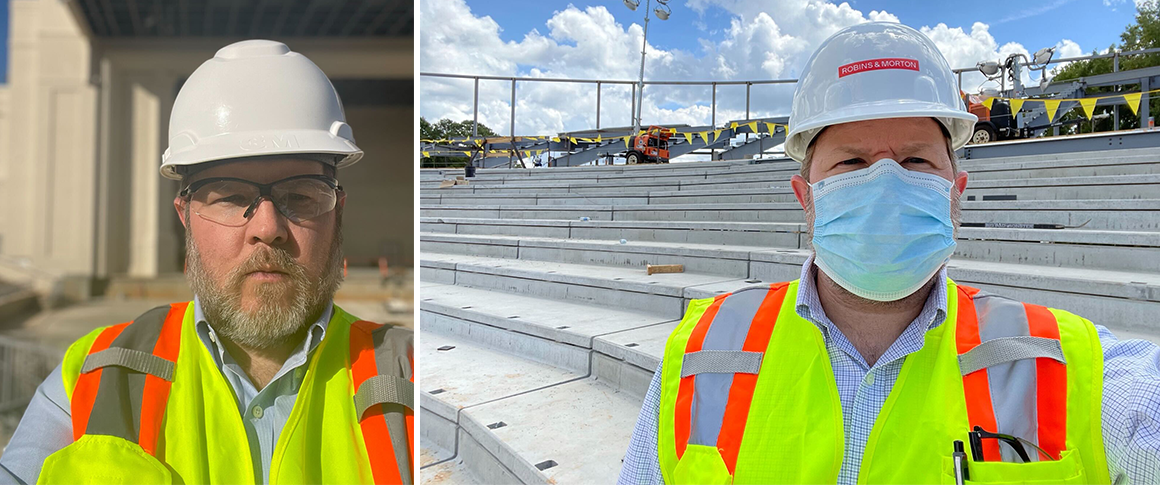
Create Your NCARB Record
Inspired by Joshua's story? Get started on the path to licensure by creating an NCARB Record. Your Record includes details on your educational history, work experience, current licensure status, and more.
We connected with architect Joshua Arcurio, AIA, NCARB, LEED AP, about his journey to licensure, his day-to-day routine at work, and advice for emerging professionals.
At what point in your life did you decide to pursue a career in architecture?
Very young. I was always interested in buildings and construction, so what I understood architecture to be sounded perfect. We as architects and urban designers work to create reality from fiction, and that’s at least part of why being on the job site will never lose its peculiar power over me.
What does your day-to-day job look like?
David M. Schwarz Architects, where I’ve worked for almost eight years, is a design firm that works on a broad range of project types across the country. We partner with an architect of record on our projects, meaning that most of our time is spent in the earlier design stages.
On a typical project, my role is project manager—overseeing our in-house team, coordinating with consultants, and corresponding with clients. For our Chevy Chase Lake project, a multi-phase planning and building project outside Washington, DC, that is in various stages of construction and completion, we are punching out the exteriors for two buildings and responding to submittals and RFIs for the third. Even though we do not produce construction documents or have the typical construction administration role of an architect of record, we are still highly involved with the aesthetic design intent of the project through all phases.
In the mornings, my team will get together for 10-15 minutes to update one another. At any given time during the day, we could end up reviewing prints on the wall, markups in Bluebeam Studio, looking at a physical model, walking through the project in Enscape, or heading outside to look at material samples in daylight. I’m very fortunate to work with a smart, sophisticated staff I can trust with important issues.
Were there any struggles you faced while on the path to licensure, and how did you overcome them?
Without a doubt, my biggest challenge was inertia. I didn’t get serious about licensure for a very long time after I graduated and began working; my first Architectural Experience Program® (AXP®) report was for over 7,000 hours (of course, I only received credit for half of those).
I was out of school for almost ten years before starting the exams. Getting back into a testing mindset after such a long time was quite difficult. I was balancing a young family and growing responsibilities at a new employer while trying to carve out time to prepare. Fortunately, David M. Schwarz Architects has a support system of training materials and assistance—the firm offers time off for a test and covers the exam cost itself. I used the office’s study resources, and I would take practice tests from Designer Hacks on my phone while on the train to and from work daily.
How did you stay motivated to finish the Architect Registration Examination® (ARE®)?
I started to see the value of licensure from the firm’s leadership, and my competitive nature started to kick in when younger colleagues passed their exams and got licensed.
I found I need to pull, rather than push, myself for motivation. I would go a few months without thinking about the exams, but once I booked a test and the clock began ticking, I would finally focus on preparing. Even though I passed all the tests on the first try, not once did I feel confident after any of the exams. Because of that, I kept the same study and practice routine throughout.
What is your favorite project you have worked on so far?
The Orion Amphitheater in Huntsville, Alabama, is, without a doubt, the coolest project I’ve worked on yet. I live for music—I’m still a college radio DJ at heart—so the opportunity to design a venue with the explicit goal of being special enough to draw artists who otherwise would not tour there is something that I will cherish forever. We consulted with incredibly wise people, from acousticians to tour managers to security experts, to craft something unique, meaningful, and functional for patrons and artists. It’s never lost on me that a client, in this case, the city, trusts us with their money and their identity.
What advice would you give licensure candidates?
First, while I found I leaned on my work experience just as much as the study materials in answering the exams, I would not recommend waiting as long as I did to sit for the tests. The benefit of licensure to your career far outweighs the testing advantage, and life can much more easily get in your way as you get older.
I think there’s comfort in developing a test day routine to help allay the day-of jitters. I needed a coffee and cram session, then a walk before going to the testing center. I remember reading David Lynch ate the same thing for lunch every day—that the regularity of peripheral things allowed his mind to work.
I always advocate for entering that first test with the mindset that it is just an expensive practice. No prep test prepares you for the testing center environment. I wanted to feel as physically comfortable as possible to focus on the questions best. It may not matter as much for others, but seemingly trivial things like wearing a cardigan instead of a pullover in case you are too hot can make a difference. Schedule your tests for the time of day when you’re sharpest.
Trust what you know about the material and yourself. If you pass, that snowball is starting down the hill, and you have momentum; if not, use what you learned to improve for the next time.
